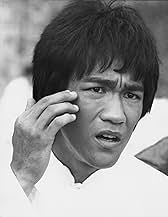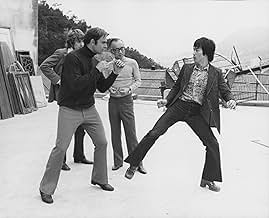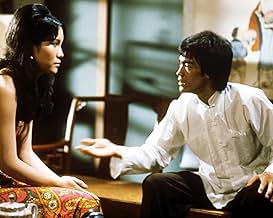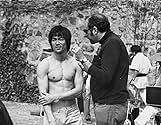Lee, un adepte des arts martiaux, participe à un tournoi de karaté organisé sur l'île forteresse de Han, un baron du crime, afin de l'espionner.Lee, un adepte des arts martiaux, participe à un tournoi de karaté organisé sur l'île forteresse de Han, un baron du crime, afin de l'espionner.Lee, un adepte des arts martiaux, participe à un tournoi de karaté organisé sur l'île forteresse de Han, un baron du crime, afin de l'espionner.
- Récompenses
- 1 victoire au total
- Oharra
- (as Bob Wall)
- Su Lin (Guest star)
- (as Angela Mao Ying)
- Bolo
- (as Yang Sze)
- Hood
- (as Pat Johnson)
Avis à la une
Very seventies, full of flairs, sideburns, zooms and a groovy Lalo Schifrin score; it was shot on location in Hong Kong without bothering to record any sound, the dialogue and sound effects obviously post-synced.
Although billed third, the delectable Ahna Capri actually gets sadly little screen time.
Don't get me wrong, I love Jackie Chan and Jet Li and even the few Chow Yun Fat roles involving martial arts, but each of these actors have their own, very big, personalities, and - at least in the case of Chan - have built their own unique legend. Unlike his successors, what Lee excelled at was the intense physicality and drama of his performance. He worked every muscle of his body in every beautifully choreographed fight scene of Enter The Dragon, and made art out of violence in ways that today's Hollywood gun violence schlock-directors can only dream of. And Enter the Dragon is one of his most stunning vehicles.
The pseudo-Taoisms are kept to a minimum and concentrated near the beginning of this film. Lee enters a martial arts tournament to avenge the murder of his sister, and to defend the honor of the Shao Lin Temple, where he helps to train young martial artists. John Saxon, a down-on-his luck playboy and brigand is the closest thing to a co-star, and comes to the tournament hoping for a solution to his financial problems. The tournament is hosted by a mass-murdering heroin manufacturer who hides his production facilities, literally, beneath a martial arts school, using the instructors and students in the school as an army of body guards. Kien Shih is absolutely compelling as the evil Han, even if his fight scenes are, at times, a bit less convincing than the master Lee's. Lee and Shih are the performance highlights of the film. Though Saxon does a passable job, his performance is a bit fibrous at times.
Worth seeing for the sets and settings alone, this film is driven well by its fast pace, simple but engaging story line, and the sheer talent of Bruce Lee. Of course, there are the usual problems of the martial arts genre - villains whose sense of honor for the most part only applies to life-threatening situations fighting would-be heroes, the lack of any weapons besides fists and unused knives, unnecessary nude scenes - it is very easy to overlook these problems and just enjoy the film.
Highly recommended.
The last film that he completed before his death, 1973's "Enter the Dragon," has become not only a masterful showcase for Lee's talents (both fighting and acting), but in the 31 years since its release has become perhaps the definitive martial arts movie of all time.
Lee, in his first and last English-speaking performance, stars as a martial arts expert who is recruited by the British government to infiltrate an island fortress, under the cover of being invited to a martial arts tournament, to investigate a possible slavery/drug ring led by a former nemesis of his.
Indeed something is amiss at this isolated island fortress, as he discovers that his nemesis Han (Shih Kien) is the host of the tournament and is also the leader of the same gang that murdered his sister. Soon enough, Lee, together with two other martial artists, Roper (John Saxon) and Williams (Jim Kelly), go to work kicking a** everywhere until the final showdown with the murderous, one-handed villain Han in the classic "Hall of Mirrors" fight sequence.
"Enter the Dragon," a joint American-Chinese production, was intended to be Bruce Lee's introduction to Western audiences, but due to his tragic death just weeks before the film's American release, we will never know what he would have been capable of here in the states. Even more tragically, his son Brandon Lee would experience a similar fate just like his father only 20 years later with "The Crow."
There are so many classic fight scenes, which I can watch over and over without them ever becoming boring. Many of them still hold up very well, especially by 2004's standards, where fight scenes are mostly digitally enhanced or involve "wire" or "Matrix-fu" to make up for lack of actual stunt work; plus one has to remember that this film was made in 1973, in the days before wirework would become dominant in today's martial arts cinema. The "Cavern Fight" is probably my favorite fight sequence of all time, in any martial arts movie.
Many of the fights in this movie, more specially the ones where Lee is involved, have a surreal feeling to them. He brings a kind of grace to his action scenes that have yet to be topped by any actor alive today. Lee even brings many of his own personal philosophies to this film, which makes much sense and perhaps help to understand some of the more philosophical elements to the story. But more than anything, this was Bruce Lee's entrée to Americans; many people, including myself, were introduced to martial arts cinema through "Enter the Dragon."
There are also several cameos made by future martial arts stars that would eventually reach stardom, most notably Jackie Chan (as a henchman during the "Cavern Fight" sequence who has his neck broken by Lee) and Sammo Hung (as Lee's sparring partner in the opening fight sequence).
I could go on and on about what makes this movie immortal, but I feel I should let you see what makes it great. Bruce Lee was forever immortalized with this film and it will be cherished and praised forever.
Used primarily as a vehicle for the late, great Bruce Lee this movie has a thin plot, little actual character development and the acting isn't fantastic.....it was never meant to be another Citizen Kane. Its merit lies purely in the action content. If you were to ask any learned martial artist I'm sure that 9 out of 10 would tell you that the fight sequences are unparalleled, even today. The fluidity of Lee is astounding. Unlike most martial arts films of that time the fighting is very realistic, and has a somewhat visceral quality. There is also the use of traditional Oriental weapons (nunchaku, escrima sticks, etc..), although the British censors in their wisdom have seen fit the cut the nunchaku sequence, and I'm afraid, like any censored movie, it just isn't the same watching when you know you aren't getting the full monty, so to speak.
Still, on the whole one of my personal favourites and a must see for any action or seventies film fan. If you get the opportunity see the remastered American version with added footage....I've got one,envy me!!!
Le saviez-vous
- AnecdotesBruce Lee actually struck Jackie Chan in the face with one of his fighting sticks. Chan admitted that it was his own fault: he wasn't where the fight choreography required him to be, and would have been fine if he'd been on his mark. In any case, Lee was so horrified that he immediately helped Jackie up and hugged him while apologizing profusely, and later insisted that Chan could work on all of his movies after that. Unfortunately, Lee died before he could keep his promise, but Chan still claimed the moment was one of the greatest things that has happened to him in his entire career (he even admitted that he hammed up how much pain he was in because he didn't want Lee to stop hugging him).
- GaffesMr. Han moves his left hand before it is revealed to be fake.
- Citations
Lee: [Lao approaches Lee; both bow] Kick me.
[Lao looks confused]
Lee: Kick me.
[Lao attempts kick]
Lee: What was that? An exhibition? We need emotional content. Try again.
[Lao tries again, but with more aggression]
Lee: I said "emotional content". Not anger! Now try again... with me.
[Lao tries again and succeeds]
Lee: That's it! How did it feel to you?
Lao: Let me think...
[Lee smacks his head]
Lee: Don't think. FEEL! It is like a finger pointing away to the moon.
[Lee looks at Lao, who is looking at the finger; Lee smacks him again]
Lee: Don't concentrate on the finger, or you will miss all that heavenly glory. Do you understand?
[Lao bows; Lee smacks him again]
Lee: Never take your eyes off your opponent... even when you bow.
[Lao bows again, this time keeping his eyes on Lee]
Lee: That's it.
[Lao walks away; opening credits begin]
- Versions alternativesTo celebrate the movie's the 25th Anniversary, 10 minutes originally not shown in the US version (but shown in the Chinese version) were restored, although it said only 3 minutes on the box. According to Linda Lee Cadwell, Bruce Lee's widow, this is the uncut version. Also included is "Bruce Lee: In his own words," the original theatrical trailer, a special "Behind the Scenes: The Filming of 'Enter the Dragon'" documentary, and never before seen photos.
- ConnexionsEdited into Le Jeu de la mort (1978)
Meilleurs choix
Détails
- Date de sortie
- Pays d’origine
- Langues
- Aussi connu sous le nom de
- Operación dragón
- Lieux de tournage
- Sociétés de production
- Voir plus de crédits d'entreprise sur IMDbPro
Box-office
- Budget
- 850 000 $US (estimé)
- Montant brut aux États-Unis et au Canada
- 25 259 $US
- Montant brut mondial
- 115 762 $US
Contribuer à cette page

































